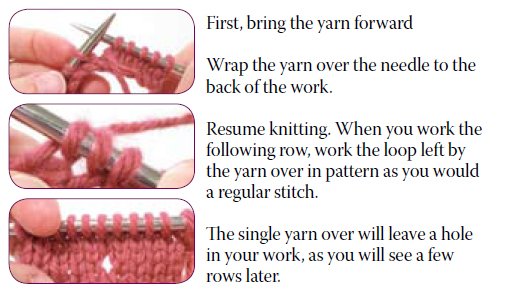yo, ssk, k2tog… Crack the Code to Lace Knitting
Lace patterns use combinations of different increase and decrease methods in order to make airy, textured patterns. Here are instructions for some of the most commonly used single increases and decreases
Yarn Over Increases
An easy way to make an increase in your knitting is to yarn over (yo). This does, however, create a hole in your work. For this reason, it is primarily used as an increase in lace knitting and other pieces where open space is intentional or decorative. To complete a yarn over, simply bring the yarn to the opposite side of the work than it had been on (from back to front or from front to back) over the needle and then continue your row as indicated. By bringing the yarn to the opposite side of the work, you are causing an extra length of yarn to lie across the needle when you complete the next stitch. The example shows a yarn over in stockinette stitch on a knit row.

To work a yarn over increase at the beginning of a knit row, bring your yarn to the front of your work and knit the first stitch of the row. To knit that first stitch, you move the yarn from the front to the back over the top of the right needle tip while it is inserted into the first stitch. To work a yarn over increase at the beginning of a purl row, bring your yarn to the back of your work and purl the first stitch of the row. You will bring the yarn from the back to the front over the right needle to purl this first stitch.
Make 1 Increase: right- or left-slanting single increase
The make 1 or M1 (also known as the lifted make 1) is an easy and very tidy looking increase. It utilizes the running thread between two live stitches to create a new stitch. This increase can lean to the left or to the right depending on which direction you pick up the new stitch.

Ssk: left-slanting single decrease
Ssk is an abbreviation for slip, slip, knit. It involves slipping two stitches from the left needle to the right needle as if to knit (one at a time, please) and then working them through the back loop as though they were one stitch. Completing an ssk creates a decrease in your knitting because you are getting rid of two stitches and replacing them with one stitch. This decrease slants to the left.

k2tog: right-slanting single decrease
K2tog is an abbreviation for knit two together. It involves knitting two stitches together as though they were one stitch. Completing a k2tog creates a decrease in your knitting because where once there were two stitches; there is now only one stitch. This decrease slants to the right.

Using slanting decreases for visual effect
When knitting garments, you usually match your increases and decreases in pairs in order to have them mirror each other. For example, a ssk at the beginning of a row would be followed with a k2tog at the end of the row.
Lace patterns mix together a variety of different increase and decreases to achieve different visual effects. Pay careful attention to the type of increase or decrease indicated in your pattern. If you inadvertently substitute a k2tog for a ssk, it will alter the look of the final lace fabric.

